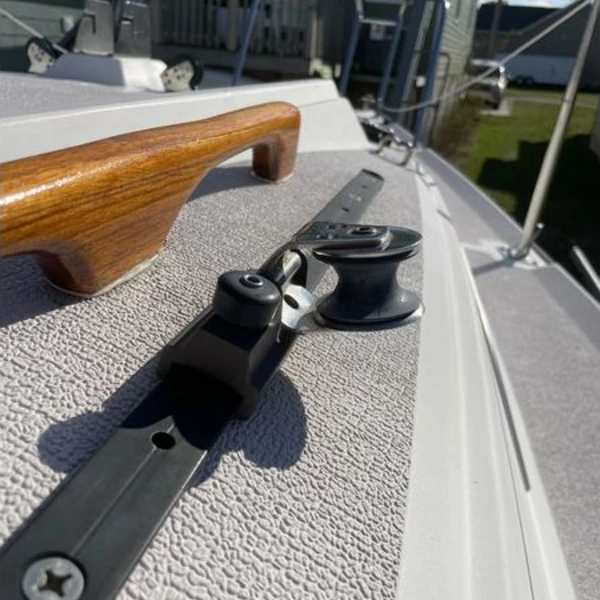Seller's Description
Dolphin Dance is a well loved 2001 Precision 21 sailboat. However, we have upgraded to a larger boat and it is time to move on. She has been dry sailed on the Great Lakes most of her life, with the occasional extended stay in a slip. She was a freshwater boat until we bought her in 2019, where she was kept during summers in Lewes DE. Her hull as been polished every year. Bottom paint done every other year, and all brightwork is refinished yearly with Cetol. Come see this beautiful example of a quality Jim Taylor designed yacht and enjoy the remainder of the fall sailing season!
Equipment: 2022 Tohatsu 4 stroke 6HP (Like New) Original Main and 100% furling Jib (Good Condition) Backup Main and Hank-On Jib (Fair Condition) Backup Rudder and Tiller (Good Condition, needs revarnish) Trailer (Good condition new tires 2020 and bearings serviced)
Harken 8 wenches (Just serviced) Pettit Vivid Bottom Paint (1 year old) All bright work refinished New Cockpit access port (2023) Chainplates re-bedded (2021) V-Birth Hatch re-bedded (2021)
Specs
- Designer
- Jim Taylor
- Builder
- Precision Boat Works
- Associations
- ?
- # Built
- ?
- Hull
- Monohull
- Keel
- Stub + Centerboard
- Rudder
- ?
- Construction
- FG
Dimensions
- Length Overall
- 20′ 11″ / 6.4 m
- Waterline Length
- 17′ 5″ / 5.3 m
- Beam
- 8′ 0″ / 2.4 m
- Draft
- 1′ 8″ / 0.5 m — 2′ 0″ / 0.6 m
- Displacement
- 1,870 lb / 850 kg
- Ballast
- 600 lb / 272 kg
Rig and Sails
- Type
- Sloop
- Reported Sail Area
- 203′² / 18.9 m²
- Total Sail Area
- 192′² / 17.8 m²
Mainsail
- Sail Area
- 113′² / 10.5 m²
- P
- 23′ 8″ / 7.2 m
- E
- 9′ 6″ / 2.9 m
- Air Draft
- 29′ 11″ / 9.1 m
Foresail
- Sail Area
- 79′² / 7.4 m²
- I
- 22′ 8″ / 6.9 m
- J
- 6′ 11″ / 2.1 m
- Forestay Length
- 23′ 9″ / 7.2 m
Auxilary Power
- Make
- ?
- Model
- ?
- HP
- ?
- Fuel Type
- ?
- Fuel Capacity
- ?
- Engine Hours
- ?
Accomodations
- Water Capacity
- ?
- Holding Tank Capacity
- ?
- Headroom
- ?
- Cabins
- 1
Calculations
- Hull Speed
-
7.2 kn
Classic: 5.6 kn
Hull Speed
The theoretical maximum speed that a displacement hull can move efficiently through the water is determined by it's waterline length and displacement. It may be unable to reach this speed if the boat is underpowered or heavily loaded, though it may exceed this speed given enough power. Read more.
Formula
Classic hull speed formula:
Hull Speed = 1.34 x √LWL
A more accurate formula devised by Dave Gerr in The Propeller Handbook replaces the Speed/Length ratio constant of 1.34 with a calculation based on the Displacement/Length ratio.
Max Speed/Length ratio = 8.26 ÷ Displacement/Length ratio.311
Hull Speed = Max Speed/Length ratio x √LWL
- Sail Area/Displacement
-
21.4
>20: high performance
Sail Area / Displacement Ratio
A measure of the power of the sails relative to the weight of the boat. The higher the number, the higher the performance, but the harder the boat will be to handle. This ratio is a "non-dimensional" value that facilitates comparisons between boats of different types and sizes. Read more.
Formula
SA/D = SA ÷ (D ÷ 64)2/3
- SA: Sail area in square feet, derived by adding the mainsail area to 100% of the foretriangle area (the lateral area above the deck between the mast and the forestay).
- D: Displacement in pounds.
- Ballast/Displacement
-
32.0
<40: less stiff, less powerful
Ballast / Displacement Ratio
A measure of the stability of a boat's hull that suggests how well a monohull will stand up to its sails. The ballast displacement ratio indicates how much of the weight of a boat is placed for maximum stability against capsizing and is an indicator of stiffness and resistance to capsize.
Formula
Ballast / Displacement * 100
- Displacement/Length
-
156.5
100-200: light
Displacement / Length Ratio
A measure of the weight of the boat relative to it's length at the waterline. The higher a boat’s D/L ratio, the more easily it will carry a load and the more comfortable its motion will be. The lower a boat's ratio is, the less power it takes to drive the boat to its nominal hull speed or beyond. Read more.
Formula
D/L = (D ÷ 2240) ÷ (0.01 x LWL)³
- D: Displacement of the boat in pounds.
- LWL: Waterline length in feet
- Comfort Ratio
-
9.4
<20: lightweight racing boat
Comfort Ratio
This ratio assess how quickly and abruptly a boat’s hull reacts to waves in a significant seaway, these being the elements of a boat’s motion most likely to cause seasickness. Read more.
Formula
Comfort ratio = D ÷ (.65 x (.7 LWL + .3 LOA) x Beam1.33)
- D: Displacement of the boat in pounds
- LWL: Waterline length in feet
- LOA: Length overall in feet
- Beam: Width of boat at the widest point in feet
- Capsize Screening
-
2.7
>2.0: better suited for coastal cruising
Capsize Screening Formula
This formula attempts to indicate whether a given boat might be too wide and light to readily right itself after being overturned in extreme conditions. Read more.
Formula
CSV = Beam ÷ ³√(D / 64)
- Beam: Width of boat at the widest point in feet
- D: Displacement of the boat in pounds
This listing is presented by SailboatListings.com. Visit their website for more information or to contact the seller.


























